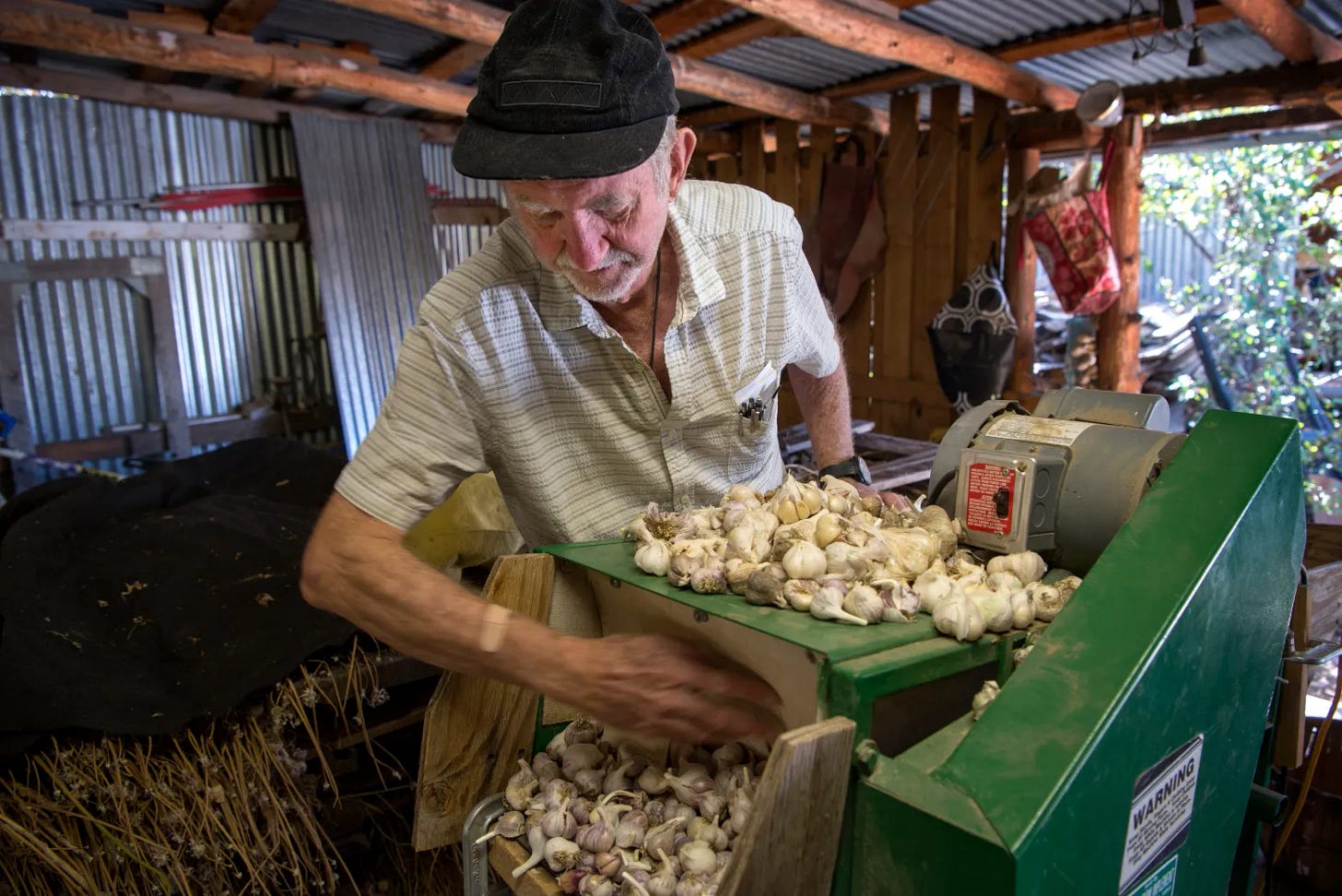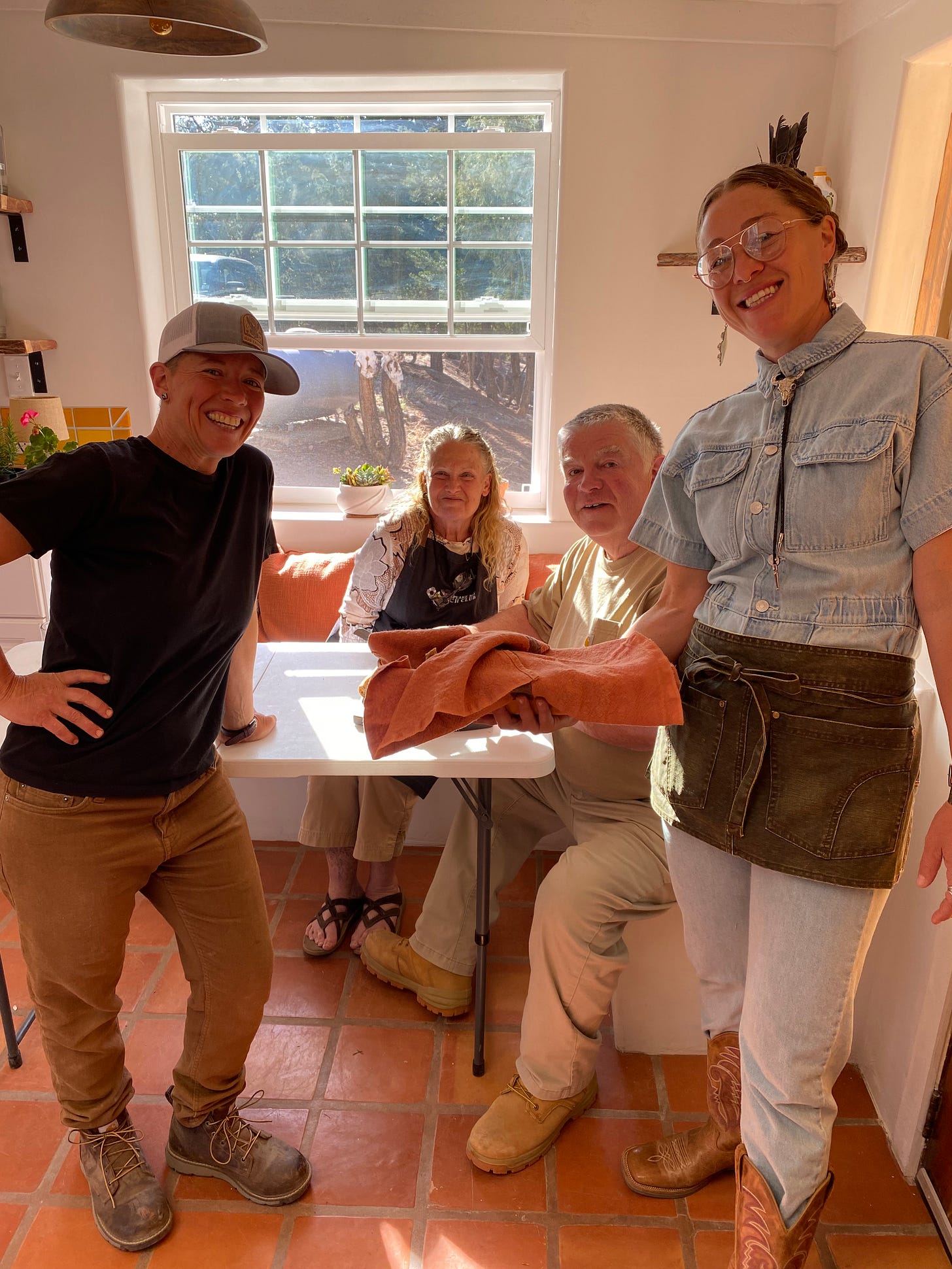Two weeks ago, we ran out of garlic. Not the often molded grocery store kind, but the good stuff—the garlic we grew in our raised beds last year, mixed with bulbs I bought from Ric, the vegetable farmer who lives down the freshly graded, currently flooded dirt road from us. Ric might be even more of an introvert than I am—bless his heart, his produce, and his veggie starts, without which our garden wouldn’t stand a chance.
There was a time, though, when my wife and I didn’t eat garlic at all. In our twenties, when we were raw to the influence of health gurus and spiritual teachers, we gave it up completely. They claimed that alliums dull the brain, cloud concentration, and poison the thoughts. Supposedly, even NASA forbids astronauts from eating garlic before space travel—for the same mind-numbing reasons. I was too timid back then to question any of it, though I secretly wanted to say, “Interesting theory—especially since no one’s actually been to the moon.” But I stayed quiet. Twenty-something and sheepish. Twenty-something and soul searching. Twenty-something and thinking I was nailing adulthood.
I avoided alliums to keep the peace.
There’s a reason people say, “Forty—and no longer giving a damn.”
Almost on cue, just after my 40th birthday—celebrated with neighbors over homemade cheesecake by the woodstove, the sweet scent of piñon pine in the air as we talked of our soon-to-be spring gardens and future flocks—garlic made its triumphant return to our kitchen. Along with it came onions, leeks, scallions, and every other allium bulb we could get our hands on.
Did my brain feel clearer without them? Did I ascend to the sixth dimension? Did my gut transform into a biodiverse wonderland? Did I become an astronaut?
Not quite.
None of those things happened during my decade-long allium family sabbatical.
What I did come to realize—somewhere in the stumbling, truth-seeking walk of my thirties—is that while strict dietary theories can have an effect, it’s often not the one we expect. The real impact I’ve seen from rigid food rules loaded with pseudoscience and perfectionism? A fleeting sense of power. Of control. A temporary illusion that we can fix everything in our lives if we just eat the “right” way.
Last week, my 4’9, Sicilian, green-thumbed mother came to visit. We spent her stay loading up the raised beds with compost—fermented cow pies, broken-down food scraps, and chicken scat, all produced right here on the farm. My Virgo moon hates to waste anything, even a drop of compost. Everything has a purpose, everything has a use, doesn’t it?
Over two sun-drenched days, our fingernails black from digging in soil, we tucked 400 onion starts into the ground—thanks, once again, to Ric. Whether they make it through the May floods is another story. It’s been relentlessly raining for a week straight, after a seven-month dry spell. The desert, long parched and cracked, is now heavy with water, soaked to its bones and waiting—like the rest of us—for the sun to return and do its work.
Truthfully, we’re all aching for it. My soul needs that light. Our chickens need it to fluff their feathers dry. Our cows need firmer ground beneath their hooves. Yes, water is life. But so is a sky wide open, unapologetically clear, pouring pure, unfiltered sunlight over everything that hopes to root into this clay-laden earth, rise, and thrive. Sun, not rain, is the norm in New Mexico—and it’s a part of why I live here. That, along with the wild land, the cowboy grit, and the wonderfully eccentric people, make this place home.
If the onions make it, I’ll store them in our pantry to last through the winter. I’ll give heaps to our neighbor, Funny, the sweetest seventy-something-year-old widow who lives just east of us and always brings homemade rhubarb jam, freshly dug black currant plants, or her infamous banana bread in exchange for raw milk and farm-fresh eggs. And I’ll sell the rest to garden-deficient urban dwellers in Santa Fe.
Everyone will benefit from the bounty—if, in fact, there is a bounty to reap.
As I laid my chef’s knife flat over my last clove of garlic, pausing for just a beat before giving it a firm crush for Caesar dressing (because let’s be honest, a real Caesar needs anchovies, egg yolk, and garlic), it hit me: garlic was going back on the grocery list. Right alongside Dijon mustard, artichokes, and chicken livers (for the cats, of course). For nearly a year, it hadn’t been necessary—our pantry had been stocked with a glorious local stash, piled high in a giant tub. Nothing makes me feel safer, more nourished, more confident than a bounty of locally produced food. This is something that, in many cases, not even money can buy anymore. Tomatoes are grown under grow lights. Lettuces are grown via hydroponics—an artificial environment that allows greens to grow year-round (but at what cost?!?). And garlic, I soon realized, even the organic varieties, is the furthest from local you (or I) could have imagined.
But now, the garlic tub was empty for the first time in twelve months.
When I walked into the grocer, I made a beeline straight for the garlic. But the old wooden bin was empty—not a single bulb in sight. Had they moved it? Were they in the middle of restocking?
Just then, Clarke approached—a lanky 5'11" guy with the kind of community spirit you’d expect from a textbook Aquarian.
“Hi, Heathar,” he said. “Our garlic supplier is in China, and there’s been a shortage for weeks.”
He embarrassedly looked down at his shoelaces, shifting his weight from left to right. “I hate buying garlic from China,” he admitted.
Clarke, the voice, heart, and hustle of the small town co-op, looked up at my wife and me. “Can you grow some this year? If you do, I’ll buy as much as you can sell.”
I stood there like a deer in the headlights. Chinese garlic? What in the actual hell? Why is this the first I’m hearing of this? This is the garlic being sold at health food stores and organic grocers across the U.S.—labeled organic?
It’s a perfect example of why labels and certifications can mean next to nothing.
Let me explain.
Many imported foods are held to very different standards than those produced domestically. “Grass-fed” meat, “organic” produce, and yes, “organic” garlic, can all meet U.S. labeling requirements—even if they were grown using flawed methods abroad.
This is one reason I strongly discourage buying meat or other perishables outside your country (or most things, for that matter).
Take garlic, for instance. China is the world’s largest exporter of organic garlic. In fact…
Over 80% of the organic garlic sold in U.S. supermarkets comes from China.
Here’s the issue: China’s organic standards are notoriously weak, and oversight is minimal. Fraud in organic labeling is common, and garlic is no exception. Chinese garlic is often bleached to appear clean and white, irradiated to kill pests, and grown under exploitative labor conditions where workers are grossly underpaid.
This isn’t the romantic image of the small organic farmer you (or I) picture when placing those dirt-covered bulbs into your Make Lard Not War shopping tote.
This fall, I’ll be planting as much garlic as I can. Planting is the easy part—it’s the waiting that takes something deeper. Garlic needs time, a cold, wet winter, and a good dose of patience to reach its full potential.
How YOU are the solution
If you want to avoid Chinese garlic hiding behind questionable organic labels, I encourage you to grow your own. Or find a local farmer and stock up—garlic stores beautifully in a cool, dry place. Just don’t refrigerate it. (And while we’re at it, let’s add tomatoes, onions, citrus, and eggs to the “never refrigerate” list.)…
Meet Stan Crawford—the legendary small-town garlic farmer who used to live just down the road from me before his recent passing. Stan didn’t just grow garlic; he waged a quiet war against the corporate giants flooding the U.S. with fraudulent “organic” imports. He took on Harmoni International Spice—an American front for the Chinese exporter Zhengzhou Harmoni Spice, the dominant supplier of so-called organic garlic in the U.S.—and sparked what many now call The Global Garlic War. A necessary battle. And one that still needs fighting.
If you’re like me—not exactly the picket-sign-waving, megaphone-carrying type—there’s still a way to stand your ground. Grow your own garlic. Or buy it from a farmer down the road. It’s a small act with big impact—on your health, on the soil, on our local economy, and on the deeper web of community and self-reliance we’re all trying to rebuild.
As Stan once wrote, “To dream a garden and then to plant it is an act of independence and even defiance to the greater world.”
You can read “The Garlic Papers,” one of his many fantastic works as a creative writer and farmer.
Let’s keep dreaming—and planting.
With heart,
Heathar
Me + my wife & my parents after our recent onion planting + first farm dinner of 2025 festivities.
PS: Stay tuned for Part II of my healthy drinking water series. Next up, Hydrogen Water, why it’s a hoax and why you shouldn’t waste your money on it.
💫 Heathar isn’t just a chef and homesteader. She’s also a homeopathic practitioner. If you're curious to explore homeopathy or deepen your practice, check out her Study Homeopathy Substack to learn more.






Great story! I am so happy to see that you are able to treat your parents and that they get to take pride in your endeavors xo. I had no idea about "Garlic Wars" I am lucky to have a farmers market every day of the week in a different location here in the Vegas valley. This seems to be the best I can do as far as produce and spices, but please do spill the tea ... as always ... if you think there is a distributor(s) I need to reachout to.
First off, I had a good old big laugh about the "moon landing" comment. If only we said those things out loud more often. Second, organic garlic from China?? Geez. No thank you. I'm with you on sourcing better garlic, starting with homegrown if possible. I look forward to reading Stan's writing.